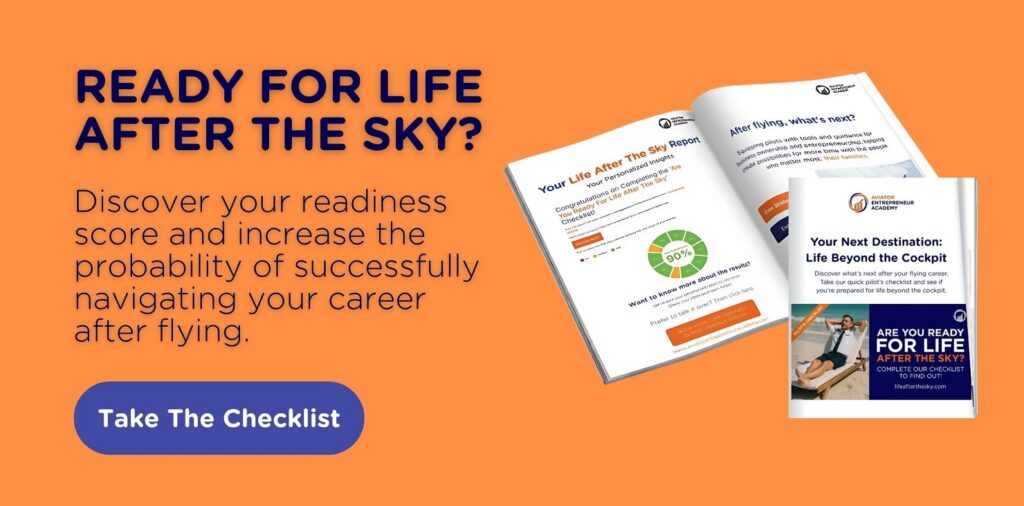Validating your idea is the equivalent of running your pre-flight checklist. It ensures you have the right conditions, resources, and demand before you commit. For pilots writing their next chapter in business, this step is not optional.
Why? Because skipping validation can lead to wasted time, money, and effort on solutions no one needs. By confirming demand early, we reduce risk and give ourselves the confidence to move forward with clarity.
In the next sections, we’ll walk through practical ways to test your idea quickly, with minimal risk, and maximum clarity.
Key Takeaways
- Don’t skip validation: Just like confirming your destination before takeoff, make sure there’s real demand before you build anything.
- Follow a checklist: Defining the problem, scanning the market, testing the concept, checking resources, and planning for risks will save you from costly mid-flight failures.
- Read the signals: Emotional, committed responses from potential customers mean you’re on the right track. Silence means changing course.
- Learn from failed tests: A no-go isn’t the end, it’s data. Adjust your route and try again.

The Validation Blind Spot
In the cockpit, pilots double-check everything. Instruments, weather, fuel, and route. Nothing is left to chance. That same precision vanishes for many pilots with this discipline when they move into business.
Here’s a common mistake. A pilot-turned entrepreneur thinks, “I have a great idea.” They start building right away, and after some weeks or months, they launch, but hear nothing from the market.
No sales. No interest. Just silence. In aviation terms, this is like filing a flight plan to an airport you’ve never confirmed exists. You can take off perfectly, but you’ll end up circling with no place to land. This is not rare. Studies show 42% of startups fail because there’s no market demand.
This shows that the problem isn’t bad execution or poor marketing. It’s that no one validated the need before building the solution.
So, how do you avoid this?
The Business Pre-Flight Checklist
Before a pilot even starts the engine, there’s a sequence of events.
The same discipline works in business. This checklist turns your idea from a risky gamble into a tested opportunity.
1. Define the Problem (Confirm the Destination)
In aviation, you check where you’re going before you leave the ground. In business, your “destination” is the problem you’re solving. Talk to potential customers, ask about their challenges, and listen more than you speak.
If they don’t feel the problem strongly, they won’t pay for the solution.
2. Research the Market (Scan the Radar)
Pilots never fly into unknown weather without scanning the radar. Your market research works the same way. You can look for existing solutions to see the size of the market.
Tools like Statista or IBISWorld give precise numbers. If the market is too small or too crowded without a clear gap, you’ll need a new plan.
3. Test the Concept (Check the Flight Path)
Before you cross the ocean, you must know how the route works. In business, this means running small tests.
Create a lean landing page, share it in pilot networks or industry groups. This way, you’ll understand how people sign up or request more info. At least thirty strong signals can validate an early idea. The number 30 isn’t random, it’s a meaningful milestone in both statistics and entrepreneurship.
In data science, 30 is often cited as the minimum sample size where patterns start to stabilize and insights become statistically useful.
4. Resources and Budget (Verify Fuel Qauntites)
You would never take off with less fuel than required. Entrepreneurs often start without enough resources. Map out your time, budget, and skills.
If you can’t cover the essentials, find partners or investors before launch. Running out of resources mid-flight is the fastest way to fail.
Someone, somewhere woke-up with the resources you need, you just need to connect the dots.
5. Plan for Risks (Review Safety Procedures)
In the air, emergencies are rare but always prepared for. In business, risks are more common. List possible obstacles, competitors, supply issues, and regulations.
In the end, simply create a plan for each. It’s easier to adjust when you’ve already thought through the scenarios.
How Pilots Can Run a Real-World Validation Test in Under 30 Days
Pilots work with fixed flight schedules. Business validation works best with the same discipline. This 30-day plan keeps you focused, fast, and accountable.
Week 1: Define the Problem and the Passenger
Start by knowing exactly who your “passenger” is. Identify your ideal customer in detail. Talk to at least 10–15 people in that group. Don’t forget to ask them about their biggest challenges related to your idea.
Listen for emotional responses as well. If people talk casually, the problem isn’t urgent, and if they lean forward and tell stories, you’re onto something.
Week 2: Build a Test Flight (MVP)
In aviation, you test a route before offering it to passengers. Here, your route is a Minimum Viable Product. It’s the smallest version of your idea that can be tested.
This could be a mockup, a short video demo, or even a simple service offer in a LinkedIn post. The goal is speed, not perfection.
Week 3: Launch to a Small, Targeted Audience
This is your first real “takeoff.” Share your MVP in pilot communities, industry forums, or niche groups. Offer something valuable in return for feedback. That could be early access, a discount, or pilot-specific benefits.
Keep a close eye on the responses. Low interest here means low interest later, no matter how polished your idea becomes.
Week 4: Review and Decide the Flight’s Future
At the end of the month, look at your “flight data.” Did people show real interest? Did they commit time, money, or contact info?
If yes, plan the next phase. But if they didn’t, adjust the route and test again.
Airlines don’t keep flying routes that lose money. Neither should you.
Lessons from Failed Test Flights
Every pilot knows that a flight ending in trouble is not the end of the story. It’s the start of an investigation. The same is true for business ideas that don’t take off.
When a test fails, the worst move is to walk away. In aviation, we pull flight data, review weather conditions, and analyze every decision. The same process applies to the business. You’ll gather data, understand the market, and trace the steps you took.
A failed test flight is not a crash on your record.
It’s training.
The goal is to find the cause, fix the approach, and take off again with better planning.
Ready to Take Off Beyond the Cockpit?
Transitioning from the flight deck to business is like switching from IFR to VFR. Different instruments, same discipline.
But skills alone aren’t enough. You need a clear understanding of where you stand now.
That’s why we’ve built the “Life After the Sky” checklist.
It’s a simple, pilot-focused tool that helps you assess your readiness for life after flying. You’ll see exactly which areas are strong and which need more preparation. The insights you get from it can save you years of trial and error.
Take the checklist today!
Invitation to join our FREE Strategy Session
Most pilots are one honest conversation away from clarity. This is that conversation.
Complete our “Life After the Sky” checklist, then join our founder and current international airline pilot, Tevin Mulavu, for a FREE 15-minute “Strategy Session” via Zoom.
This session has been created for pilots who want to take ownership of what comes next.
In just 15 minutes, we’ll:
- Review your checklist results
- Identify the one obstacle holding back your reinvention
- Translate your checklist results into a clear starting point



